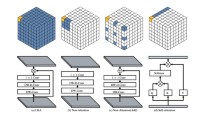Abstract
Every picture tells a story. In photography, the story is portrayed by a composition of objects, commonly referred to as the subjects of the piece. Were we to remove these objects, the story would be lost. When manipulating images, either for artistic rendering or cropping, it is crucial that the story of the piece remains intact. As a result, the knowledge of the location of these prominent objects is essential. We propose an approach for saliency detection that combines previously suggested patch distinctness with an object probability map. The object probability map infers the most probable locations of the subjects of the photograph according to highly distinct salient cues. The benefits of the proposed approach are demonstrated through state-of-the-art results on common data sets. We further show the benefit of our method in various manipulations of real-world photographs while preserving their meaning.























Similar content being viewed by others
References
http://cgm.technion.ac.il/Computer-Graphics-Multimedia/Software/ImMnplSal
Achanta, R., Hemami, S., Estrada, F., Susstrunk, S.: Frequency-tuned salient region detection. In: CVPR, pp. 1597–1604 (2009)
Achanta, R., Shaji, A., Fua, P., Süsstrunk, S.: Image summaries using database saliency. In: SIGGRAPH ASIA Posters (2009)
Boiman, O., Irani, M.: Detecting irregularities in images and in video. Int. J. Comput. Vis. 74(1), 17–31 (2007)
Bruce, N., Tsotsos, J.: Saliency based on information maximization. In: NIPS, vol. 18, p. 155 (2006)
Cheng, M.M., Zhang, G.X., Mitra, N.J., Huang, X., Hu, S.M.: Global contrast based salient region detection. In: CVPR, pp. 409–416 (2011)
Collomosse, J.P., Hall, P.M.: Painterly rendering using image salience. In: Eurographics, 2002, pp. 122–128 (2002)
Everingham, M., Van Gool, L., Williams, C.K.I., Winn, J., Zisserman, A.: The Pascal visual object classes (VOC) challenge. Int. J. Comput. Vis. 88(2), 303–338 (2010)
Goferman, S., Zelnik-Manor, L., Tal, A.: Context-aware saliency detection. In: CVPR, pp. 2376–2383 (2010)
Guo, C., Ma, Q., Zhang, L.: Spatio-temporal saliency detection using phase spectrum of quaternion Fourier transform. In: CVPR, pp. 1–8 (2008)
Harel, J., Koch, C., Perona, P.: Graph-based visual saliency. In: NIPS, vol. 19, p. 545 (2007)
Hays, J., Essa, I.: Image and video based painterly animation. In: NPAR, pp. 113–120 (2004)
Hou, X., Zhang, L.: Saliency detection: a spectral residual approach. In: CVPR, pp. 1–8 (2007)
Itti, L., Koch, C., Niebur, E.: A model of saliency-based visual attention for rapid scene analysis. In: PAMI, pp. 1254–1259 (1998)
Judd, T., Ehinger, K., Durand, F., Torralba, A.: Learning to predict where humans look. In: ICCV, pp. 2106–2113 (2009)
Liu, T., Sun, J., Zheng, N.N., Tang, X., Shum, H.Y.: Learning to detect a salient object. In: CVPR (2007)
Prinzmetal, W.: Visual feature integration in a world of objects. Curr. Dir. Psychol. Sci. 4(3), 90–94 (1995)
Rubinstein, M., Shamir, A., Avidan, S.: Multi-operator media retargeting. TOG 28(3) (2009)
Walther, D., Koch, C.: Modeling attention to salient proto-objects. Neural Netw. 19(9), 1395–1407 (2006)
Yeshurun, Y., Kimchi, R., Sha’shoua, G., Carmel, T.: Perceptual objects capture attention. Vis. Res. 49(10), 1329–1335 (2009)
Zeng, K., Zhao, M., Xiong, C., Zhu, S.C.: From image parsing to painterly rendering. TOG 29(1) (2009)
Zhang, G., Cheng, M.M., Hu, S.M., Martin, R.R.: A shape-preserving approach to image resizing. Comput. Graph. Forum 28(7), 1897–1906 (2009)
Acknowledgements
This research was supported in part by Intel, the Ollendorf foundation, the Israel Ministry of Science, and by the Israel Science Foundation under Grant 1179/11.
Author information
Authors and Affiliations
Corresponding author
Rights and permissions
About this article
Cite this article
Margolin, R., Zelnik-Manor, L. & Tal, A. Saliency for image manipulation. Vis Comput 29, 381–392 (2013). https://doi.org/10.1007/s00371-012-0740-x
Published:
Issue Date:
DOI: https://doi.org/10.1007/s00371-012-0740-x




